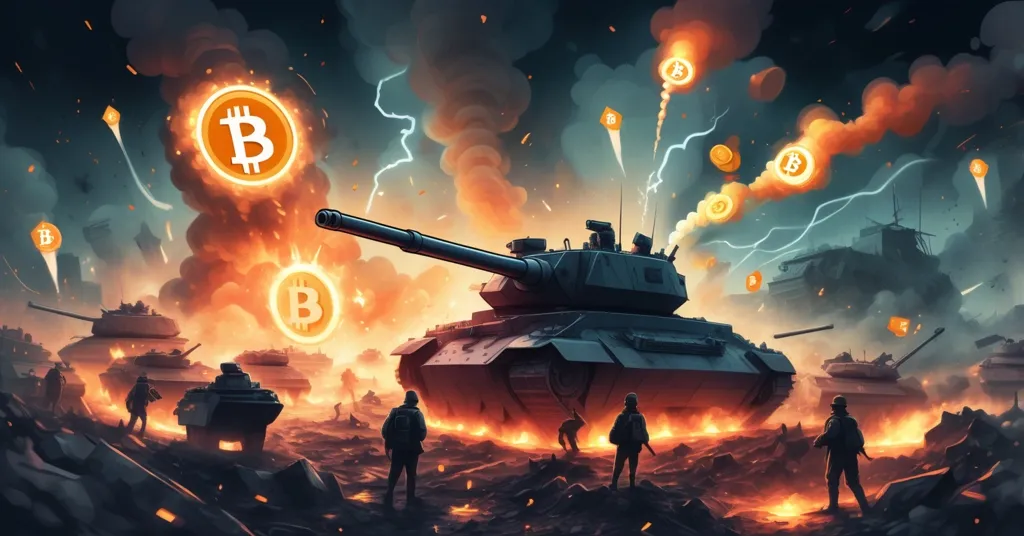Bitcoin as Safe Haven: Geopolitical Chaos and Ukraine’s $100B Deal Fuel Debate

Geopolitical Standoff and Stagnant Markets: Is Bitcoin the Real Safe Haven?
Amidst a tense Washington meeting between Donald Trump and Volodymyr Zelenskyy, a $100 billion weapons deal for Ukraine was tabled, funded by European governments, with no ceasefire in sight for the brutal conflict with Russia. While stock markets barely flinched, the crypto community might see a glaring signal: in a world of geopolitical chaos and financial weaponization, could Bitcoin and decentralized finance (DeFi) offer the stability traditional systems lack?
- Major Deal, No Peace: $100 billion weapons proposal for Ukraine, European-funded, alongside a $50 billion drone plan, but no ceasefire with Russia.
- Markets Unfazed: Dow down 0.08%, S&P 500 flat, Nasdaq up 0.03%, as traders eye Federal Reserve moves over war news.
- Crypto Opportunity: Geopolitical unrest and frozen asset disputes bolster the case for Bitcoin as a safe haven and DeFi as an alternative to state-controlled finance.
Unpacking the Ukraine Weapons Deal
Picture a high-stakes room in Washington: Trump, Zelenskyy, and European leaders hashing out Ukraine’s defense against Russia’s relentless aggression, ongoing since the 2022 invasion. Zelenskyy laid out an ambitious plan—a $100 billion package to procure American weapons, entirely bankrolled by European governments, paired with a $50 billion initiative for joint U.S.-Ukrainian drone production. He also requested 10 U.S.-made Patriot missile systems to protect cities and critical infrastructure from Russian strikes. Beyond hardware, Ukraine seeks ironclad U.S. security guarantees for the aftermath of any peace deal. Trump, playing the businessman, shut down any notion of charity.
“We’re not giving anything. We’re selling weapons,”
he declared, underscoring a policy rooted in American economic gain over traditional aid. For more on this meeting, check out the latest report on the Trump-Zelenskyy discussions.
The diplomatic battlefield remains muddy. Zelenskyy holds firm that a ceasefire must precede any deeper peace talks, a view shared by German Chancellor Friedrich Merz, who pressed for an immediate halt to violence.
“I can’t imagine that the next meeting would take place without a ceasefire. So let’s work on that and let’s try to put pressure on Russia because the credibility of these efforts we are undertaking today depends on at least a ceasefire,”
Merz argued. Yet, Trump—after a recent sit-down with Vladimir Putin in Alaska—has pivoted from ceasefire advocacy to demanding a full peace agreement without preconditions. Ukraine, meanwhile, refuses territorial concessions and demands full financial compensation from Russia, potentially drawing from $300 billion in frozen Russian assets held in Western jurisdictions. Russia’s reaction? Kremlin propagandist Vladimir Solovyov sneered on state media, claiming Russia could
“destroy the U.S. with nuclear weapons,”
a chilling jab at Trump’s perceived lack of leverage. Dive into the details of this massive $100 billion weapons proposal.
Markets Yawn at War’s Shadow
While diplomats spar over billions and lives, financial markets couldn’t care less. The Dow Jones Industrial Average slipped a negligible 0.08% to 44,911.82, the S&P 500 held steady at 6,449.15, and the Nasdaq Composite inched up 0.03% to 21,629.77. Futures for these major indices—key barometers of U.S. market health—showed no real pulse either. Even tech heavyweights like Meta Platforms, down 2.3%, and Microsoft, off 0.6%, failed to ignite any drama. Boring? Absolutely. But that’s the crux—traders are glued to Federal Reserve Chair Jerome Powell’s upcoming Jackson Hole speech, with an 83% chance of a September rate cut according to CME’s FedWatch Tool. Monetary policy, not missiles, dictates Wall Street’s mood, unless conflicts directly spike energy prices or disrupt commodities, as seen with Ukraine’s recent strike on a Russian oil pumping station tied to the Druzhba pipeline, impacting supply to Slovakia and Hungary. Get the latest insights on Powell’s anticipated speech and rate cut expectations.
Bitcoin’s Safe Haven Narrative in Focus
If traditional finance shrugs at war, perhaps it’s time for Bitcoin to steal the spotlight. Often called digital gold, Bitcoin (BTC) thrives on the promise of being a hedge against uncertainty—a borderless, censorship-resistant asset free from government overreach. For the uninitiated, Bitcoin is the pioneering cryptocurrency, a decentralized digital currency on a peer-to-peer network with a capped supply of 21 million coins, untouched by central banks or political whims. Historically, it’s spiked during crises. Take the 2013 Cyprus banking collapse—citizens flocked to BTC as accounts were frozen. Or Venezuela’s hyperinflation hell, where Bitcoin became a lifeline for remittances. Could Ukraine’s plight, with civilian casualties mounting in Kharkiv and Zaporizhzhia, spark a similar rush? Some investors might see it as a shield while stocks sleep through chaos. Explore more about Bitcoin’s role during geopolitical turmoil.
But let’s not get carried away—Bitcoin isn’t a guaranteed sanctuary. Its price swings are notoriously brutal, often mirroring tech stocks during risk-off periods. Geopolitical unrest might drive interest, but if broader market sentiment sours, BTC can tank alongside equities. Plus, it’s not yet mainstream enough to be the default refuge for most. Still, the philosophical hook—financial sovereignty, privacy, and sticking it to centralized control—resonates louder when states weaponize money, as we’re seeing with asset freezes and sanctions. Learn how geopolitical tensions influence Bitcoin adoption.
DeFi’s Potential Amid Financial Warfare
Enter decentralized finance, or DeFi, a sector of blockchain tech that could rewrite the rules of financial disputes. DeFi refers to applications, often built on networks like Ethereum, that let users lend, borrow, or trade without middlemen—think Wall Street minus the suits and bureaucracy. In the context of Ukraine’s push for $300 billion in frozen Russian assets, DeFi offers tantalizing possibilities. Platforms like MakerDAO could, theoretically, issue stablecoins (digital currencies pegged to real-world value) tied to such assets, acting as neutral escrow beyond state interference. Tools like Chainlink’s data oracles might track ownership on-chain with transparency, cutting through legal quagmires. Tokenized assets—digital versions of real-world holdings like funds or property—could make transfers verifiable and frictionless without intermediaries. For a deeper look at DeFi’s potential in handling frozen assets during disputes, there are compelling arguments to consider.
Yet, here’s the harsh reality: DeFi is nowhere near ready for prime time. Scalability bottlenecks, regulatory uncertainty, and sheer complexity keep it niche. Belgian PM Bart De Wever warned that seizing Russian assets could be seen as
“an act of war”
and pose
“systemic risks to the entire financial world system,”
a sentiment echoed by academics like Federico Luco Pasini from Durham University, who notes court-ordered seizures might breach international law. DeFi sidesteps some of these issues in theory, but without global adoption or legal backing, it’s a pipe dream for now. Still, the idea of blockchain as a counter to broken systems gains traction with every geopolitical flashpoint. Check out the current debate on frozen Russian assets and sanctions relief.
Russia, Sanctions, and Crypto’s Double-Edged Sword
Russia’s role in this mess adds another layer for crypto watchers. With leaders like Emmanuel Macron poised to tighten sanctions if peace talks falter, Moscow might lean harder on digital currencies to dodge financial chokeholds. Post-2014 Crimea annexation, Russia toyed with blockchain for trade settlements. Recent murmurs suggest state-backed mining operations or shadowy exchanges could ramp up if Western pressure intensifies. Bitcoin and altcoins offer a backdoor to move value across borders without SWIFT or dollar dominance—tempting for a sanctioned state. Read community perspectives on Bitcoin and DeFi’s impact during the Ukraine conflict.
But this cuts both ways. If Russia weaponizes crypto for evasion, expect the U.S. and EU to clamp down with stricter KYC (Know Your Customer) and AML (Anti-Money Laundering) rules. Global watchdogs like FATF could paint the entire industry as a haven for bad actors, screwing over legitimate users. Crypto’s freedom is its superpower, but also its biggest target. The tighter the geopolitical vise, the more regulators will hound decentralized tech—a bitter irony for a space built on disrupting the status quo. For an academic take, see this analysis of Bitcoin’s safe haven narrative during the Ukraine-Russia conflict.
Key Questions and Takeaways
- Do geopolitical tensions like the Ukraine-Russia conflict boost Bitcoin’s appeal?
Yes, they often amplify Bitcoin’s narrative as a safe haven outside government control, as seen in past crises like Cyprus and Venezuela, though its volatility can still deter cautious investors. - Can DeFi provide solutions to disputes over frozen assets?
In theory, DeFi’s transparent ledgers and tokenized systems could manage assets neutrally, but scalability and legal recognition are massive barriers to practical use today. - Will Russia’s sanctions pressure increase crypto adoption for evasion?
Likely, given Russia’s history of exploring blockchain under sanctions, though this could trigger harsher global regulations, impacting the broader crypto space. - Why are traditional markets indifferent to such conflicts, and does this signal a role for crypto?
Markets prioritize domestic economic signals like Fed rate cuts over distant wars, reflecting desensitization that could drive interest in decentralized alternatives, though crypto isn’t yet a default fallback for most. - How has Bitcoin performed in past geopolitical crises?
Bitcoin often sees spikes during uncertainty—think Cyprus 2013 or Venezuela’s collapse—as people seek non-fiat options, but it’s not immune to broader market downturns. - What risks does regulatory backlash pose to crypto during conflicts?
If states like Russia use crypto to bypass sanctions, expect tighter rules from global powers, potentially stifling innovation and burdening legitimate users with compliance costs.
Accelerating Toward a Decentralized Future?
As Wall Street obsesses over Powell’s next utterance and turns a blind eye to Kyiv’s struggle, the crypto world has a chance to redefine money’s future. Bitcoin maximalists will argue it’s the only uncorruptible store of value, a digital fortress against geopolitical storms. Fair enough, but let’s not ignore altcoins and protocols like Ethereum’s DeFi ecosystem or even stablecoins on other chains—they fill niches Bitcoin doesn’t touch, like instant, borderless aid payments for war-torn regions. Diversity in crypto might be our edge.
Still, we’re not delusional. Adoption lags, tech hurdles loom, and regulatory wolves circle, especially if bad actors exploit decentralized tools. The Trump-Zelenskyy standoff, the frozen assets saga, and market apathy all expose a creaking financial order begging for disruption. Bitcoin and blockchain aren’t perfect, but they carry the torch of freedom, privacy, and defiance against centralized failures. Are we ready to bet on them over fiat’s familiar flaws, or is this just a dreamer’s rebellion while old systems lumber on? That’s the million-BTC question staring us down.



